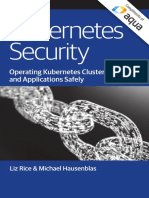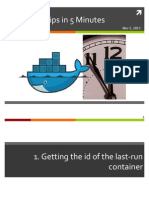Containers,
Docker, and
Microservices
Jrme Petazzoni
(@jpetazzo)
Grumpy French DevOps
- Go away or I will replace you
with a very small shell script
Runs everything in containers
- Docker-in-Docker
- VPN-in-Docker
- KVM-in-Docker
- Xorg-in-Docker
- ...
Jrme Petazzoni
(@jpetazzo)
Built and scaled dotCloud
PAAS with 106 services
(I counted them!)
- some examples: hosts, nats,
containers, builds, snapshots,
metrics, billing, user permissions,
infrastructure management, logs, ...
outline
Outline
Why microservices?
What's the challenge?
How does Docker help?
Getting started with stacks of containers
why
microservices
What is a microservice architecture?
Break big application down into many small services
Example: e-commerce
- web front-end
- catalog of products
- inventory/stock management
- shipping calculator
- payment processor
- billing/invoicing
- recommendation engine
- user profiles
Why is this useful?
Use different stacks for different services
(can be seen as both good and bad!)
Replace (e.g. refactor) individual services easily
(service boundary enforces API separation)
Decouples deployment; requires less coordination
(deploy early, deploy often; more agility)
Helps implementing Jeff Bezos' two-pizza rule
(many small teams overperform a single big team)
More effective ownership of services
what's the
challenge?
Issues we will not address today
Fast, efficient RPC calls
- ZeroRPC
- Cap'n Proto
- XMLRPC
- SOAP
- Dnode
- REST
- Queues (like AMQP), for long-running/async operations
Issues we will not address today
How to break application down in small parts
- this is not always easy
- try to get help from people who have already done it
- but: it helps to achieve a better architecture (I promise)
Issues we could address today
Our app is now spread across multiple services
Those services might (will) end up on many machines
Some of those services might (will) be scaled out
Consequences:
- our services will have to discover each other's location
- we will have to learn about load balancing
Issues we will address today
We're deploying 42 microservices instead of 1 app
We want to be able to deploy often
Obvious consequence: our deploy process must rock
- it must be fast
- it must be reliable
- it must be automated
how does
Docker help?
the big
picture
Docker's mission
build, ship, and run any application, anywhere
Say again?
Build: package your application in a container
Ship: move that container from a machine to another
Run: execute that container (i.e. your application)
Any application: anything that runs on Linux
Anywhere: local VM, cloud instance, bare metal...
build
Dockerfile
FROM ubuntu:14.04
MAINTAINER Docker Team <education@docker.com>
RUN apt-get update
RUN apt-get install -y nginx
RUN echo 'Hi, I am in your container' \
>/usr/share/nginx/html/index.html
CMD [ "nginx", "-g", "daemon off;" ]
EXPOSE 80
ship
Docker Hub
Image name should be <username>/<reponame>
e.g.: jpetazzo/web
docker push
docker pull
Docker Hub
Image name should be <username>/<reponame>
e.g.: jpetazzo/web
docker push
docker pull
It's magic!
run
Execution is fast and lightweight
Let's look at a few benchmarks
Benchmark: container creation
$ time docker run ubuntu echo hello world
hello world
real 0m0.258s
Disk usage: less than 100 kB
Memory usage: less than 1.5 MB
Benchmark: infiniband
Benchmark: boot OpenStack instances
Benchmark: memory speed
Let's start a few containers
Just for run. Eh, for fun.
any app
If it runs on Linux, it will run in Docker
Web apps
API backends
Databases (SQL, NoSQL)
Big data
Message queues
And more
If it runs on Linux, it will run in Docker
Firefox-in-Docker
Xorg-in-Docker
VPN-in-Docker
Firewall-in-Docker
Docker-in-Docker
KVM-in-Docker
anywhere
anywhere*
*Limitations may apply.
Docker has official support for:
Intel 64 bits (x86_64) code
Recent kernels (3.8 and above)
Coming soon: Windows Containers
(If you have questions about this, ask Microsoft!)
Rumors say that people also run on:
Intel 32 bits
ARM 32 and 64 bits
MIPS
Power8
Older kernels (please don't)
Note: the main issue is that the Docker Hub registry is
not arch-aware, and images are not compatible.
CONTAINERS
They're stable, they said. Stack them, they said.
running
stacks of
containers
First steps
Online tutorial (in browser, JS based, zero install)
http://www.docker.com/tryit/
boot2docker (25 MB universal VM image)
http://boot2docker.io/
Scary install script
curl -sSL https://get.docker.com/ | sh
We have ordinary packages too!
And most clouds have Docker images
Checklist
Install boot2docker
Run your first container (echo hello world)
Write your first Dockerfile
Create your Docker Hub account (free)
Push image to Docker Hub
Setup automated build
Run your first complex app with Fig
Fig
Run your stack with one command: fig up
Describe your stack with one file: fig.yml
Example: run a (one node) Mesos cluster
- Mesos master
- Mesos slave
- Volt framework
master:
image: redjack/mesos-master
command: mesos-master --work_dir=/mesos
ports:
- 5050:5050
slave:
image: redjack/mesos-slave
links:
- master:master
command: mesos-slave --master=master:5050 --containerizers=docker,mesos
volumes:
- /sys/fs/cgroup:/sys/fs/cgroup
- /var/run/docker.sock:/var/run/docker.sock
- /usr/bin/docker:/bin/docker
volt:
image: volt/volt
links:
- master:master
command: --master=master:5050
ports:
- 8080:8080
what's next?
Advanced topics
All Things Docker
http://blog.docker.com/
Running your own private registry
https://github.com/docker/docker-registry
Containers and security
http://www.slideshare.net/jpetazzo/docker-linux-containers-lxc-and-security
https://medium.com/@ewindisch/on-the-security-of-containers-2c60ffe25a9e
Service discovery
(look for ambassador pattern)
And more!
thank you!
questions?
Would You Like To Know More?
Get in touch on Freenode
#docker #docker-dev
Ask me tricky questions
jerome@docker.com
Get your own Docker Hub on prem
sales@docker.com
Follow us on Twitter
@docker, @jpetazzo





























































































